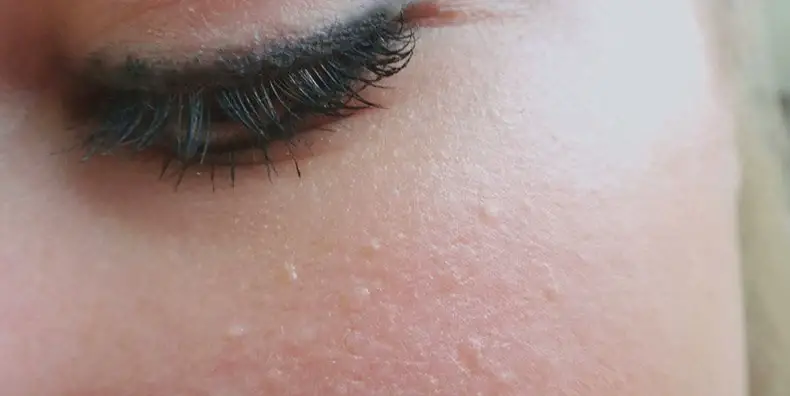
7 Causes of White Bumps on Your Skin and What to Do About Them
Finding tiny white bumps on your skin can be a bit unnerving. They might look harmless at first, but figuring out what’s causing them—and how to treat them—can be surprisingly tricky.
White bumps can appear for many reasons, from simple clogged pores to underlying medical conditions.
To help you understand what’s going on beneath the surface, we spoke with two expert dermatologists.
They shared their insights on common causes of white bumps and practical tips on how to identify and manage them.
Read on for a detailed guide to seven common types of white bumps and what you can do about each.
1. Milia: Tiny Cysts That Pop Up Anywhere
Dr. King explains, “Milia are tiny cysts just under the skin’s surface, appearing as smooth, hard white bumps.”
You often see them around the eyes or on the forehead, but they can occur anywhere on your face, neck, or chest.
Milia form when dead skin cells become trapped beneath the surface. Sometimes, they happen naturally, but they can also result from using comedogenic (pore-clogging) skincare products.
Dr. De Rosa says, “Milia often resolve on their own or with gentle exfoliation or topical retinoids.”
But if they stick around, a professional can unroof them with a needle or scalpel and extract the contents safely.
For prevention, King recommends using topical retinoids or hydroxy acids, which encourage skin cell turnover and help keep pores clear.
Avoid picking or trying to pop milia yourself—it can cause irritation or scarring.
2. Cysts: Deeper, Fluid-Filled Bumps
Cysts are small sacs filled with fluid or pus beneath the skin. Dr. De Rosa describes them as “pockets that can form due to skin irritation or sometimes without a clear cause.”
Dr. King clarifies the two main types: acne cysts and epidermal inclusion cysts (sometimes called sebaceous cysts).
Acne cysts lack a defined wall and tend to be painful, while epidermal inclusion cysts have a thick outer layer filled with keratin and oil.
These cysts can occur anywhere on the body and often require surgical removal to prevent inflammation or infection.
“Removing the entire sac or lining of the cyst is crucial,” says De Rosa, “so excision by a dermatologist is the best approach.”
If you notice a cyst growing, becoming red or painful, seek professional advice to avoid complications.
3. Clogged Pores: Whiteheads and Pimples
White bumps can simply be clogged pores. Dr. De Rosa explains, “When dead skin cells and oils get trapped inside your pores, they form whiteheads, blackheads, or pimples.”
Dr. King notes these clogs are often driven by hormonal changes or genetics. Using heavy, comedogenic skincare products can worsen the problem.
The good news: over-the-counter products containing salicylic acid or benzoyl peroxide help clear clogged pores. Prescription topical retinoids can also speed up skin cell turnover and prevent buildup.
For stubborn blackheads, professional extraction tools can help, but avoid squeezing pimples yourself to prevent scarring or infection.
4. Eczema: Chronic Inflammation with Dry, Cracked Skin
Eczema, or atopic dermatitis, can sometimes present as small white bumps along with dry, cracked, or thickened skin.
Dr. King calls eczema “the most common chronic inflammatory skin disease characterized by a disrupted skin barrier.”
Dr. De Rosa adds that eczema flare-ups can include rashes, oozing, and crusting. Stress often worsens eczema, so managing triggers is a key part of treatment.
Typical management involves avoiding irritants, using moisturizing creams, and sometimes steroid creams or light therapy to calm inflammation.
Severe cases may require systemic medications to modulate the immune response.
If you suspect eczema, seeing a dermatologist is important to get the right treatment plan and avoid worsening symptoms.
5. Vitiligo: Autoimmune Pigment Loss
Vitiligo is a condition where the immune system attacks pigment-producing cells, leading to patches of white or lighter skin.
Dr. De Rosa explains it’s “an autoimmune disease with a genetic basis, often triggered by sunburn or deep chemical peels.”
Although there’s no cure, treatments exist to manage vitiligo. Dr. King says these include topical corticosteroids, calcineurin inhibitors, and phototherapy.
A new FDA-approved topical JAK inhibitor called Opzelura offers promising results.
Some also opt for skin grafting or use camouflaging makeup to even out skin tone.
If you notice white patches or changes in pigmentation, it’s worth consulting a dermatologist for a proper diagnosis and treatment options.
6. Idiopathic Guttate Hypomelanosis (IGH): Age and Sun Exposure Spots
IGH appears as small, flat, white or light spots on sun-exposed areas, usually multiple in number. Dr. King says it’s caused by sun overexposure, aging, or genetics.
To manage IGH, Dr. De Rosa recommends sun protection with broad-spectrum SPF 30 or higher and protective clothing to prevent worsening.
Cosmetic treatments like topical corticosteroids, retinoids, laser therapy, or dermabrasion may help reduce the appearance of these spots, but they often do not fully disappear.
Limiting sun exposure and diligent sunscreen use remain the most important steps to prevent IGH from getting worse.
7. Tinea Versicolor: A Fungal Skin Infection
Tinea versicolor is caused by an overgrowth of yeast called Malassezia furfur. Dr. De Rosa explains it “can cause itchy patches of skin that may be white, brown, red, pink, or yellow.”
Dr. King adds it often causes fine scaling and discolored patches, commonly on the shoulders, chest, and back. The condition tends to recur, especially in humid or warm climates.
To prevent outbreaks, King suggests using shampoos containing selenium sulfide, like Selsun Blue, applied to affected areas to kill the yeast.
Treatment involves topical or oral antifungal medications and avoiding triggers such as excessive heat, sweating, and humidity. Early treatment reduces symptoms and recurrence frequency.
When to See a Dermatologist
White bumps on your skin can arise from many causes—some harmless and temporary, others more persistent or indicative of underlying issues.
Genetics, immune response, sun exposure, skincare routines, and infections can all play a role.
If you notice white bumps that don’t improve with home care, worsen, become painful, or are accompanied by other symptoms, the best course is to consult a board-certified dermatologist.
They can accurately diagnose the cause and recommend the safest, most effective treatments.
Avoid self-diagnosis or picking at bumps, as this can lead to irritation, infection, or scarring. With professional guidance, you can keep your skin healthy, comfortable, and glowing.


